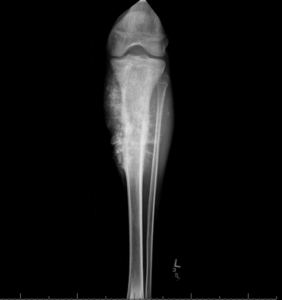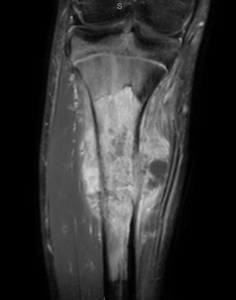July is Sarcoma Awareness Month. Sarcomas are what I study and treat, so there’s no time like the month of July to get down to the nitty gritty of these cancers.
Sarcomas are tumors that arise from connective tissue in the body. Some connective tissues are muscle, fat, bone, cartilage, and blood vessels. Sarcomas can arise from any of these tissues. There are many different types of sarcomas and all types are rare in adults, making up only about 1% of all cancers. In contrast, they are a little more common in children and account for approximately 15% of all childhood cancers. This means that only 12,000 people each year in the United States will be diagnosed with a sarcoma (adult and kids). To put this number into perspective, compare it to the 266,000 new cases of breast cancer in the U.S. each year. I’ll take the next few blogs to break down the types of sarcomas and we’ll start off with a bone tumor called osteosarcoma.
Osteosarcoma
Osteosarcoma is the most common bone cancer in children and adolescents and accounts for 2.8% of all pediatric cancers. Each year in the United States, there are an estimated 450 new cases diagnosed in patients less than 20 years of age. There are slightly more boys than girls diagnosed with osteosarcoma and slightly more African Americans than whites. The most common age of diagnosis is 16 and most cases are diagnosed between the ages of 14 and 19 years.
Most cases of osteosarcoma occur in children with no family history of cancer or associated conditions. A handful of cases each year are diagnosed in patients with cancer predisposition syndromes such as Li-Fraumeni Syndrome and a very small number of cases arise in patients who have previously received radiation therapy.
Clinical presentation and diagnosis
The most common presenting symptom is pain with or without a visible enlarging mass. Most cases of osteosarcoma develop around the knee and can be seen on X-ray and MRI.



Tumor staging and treatment
Osteosarcoma is classified as localized (non-metastatic) or metastatic. Metastatic disease means that the cancer has spread beyond its original location. Many solid tumors in childhood cancer are staged this way (yes/no) and it doesn’t follow the staging 1-4 as in adults. The most common site for osteosarcoma to spread to is the lungs and next is other bones. Approximately 20% of patients will have metastatic disease at the time of initial diagnosis. Osteosarcoma is difficult to treat if the disease has spread, and survival rates are less than 30% at 5 years, compared to 65-70% if it has not spread.
The standard treatment approach for OS patients includes chemotherapy, followed by surgical resection and then more chemotherapy. Complete surgical resection of the primary tumor is critical. Amputation of an affected limb is always an option for tumors in the extremities, but most patients are now able to have a limb sparing procedure. Limb salvage options include endoprostheis placement, bone grafting, or rotationplasty, all of which which I discussed here and here.
Unfortunately, even though patients with metastatic disease have poor outcomes, we do not have drastically different therapy to offer them despite intense efforts. They receive the same chemotherapy as patients whose disease has not spread and will get additional lung surgeries to remove any tumors found in the lungs.

One thought on “Osteosarcoma”